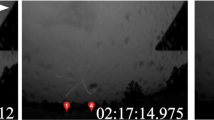Abstract
Measurements at the instrumented Gaisberg tower (GBT) along with data from the Austrian Lightning Detection and Information System (ALDIS) have played an important role in improving our understanding of upward lightning discharges. A current measuring shunt is located at the base of a 1.5 m high air terminal on top of the GBT. Between 2000 and 2018, current waveforms of 865 flashes were recorded at the GBT, of which 823 (95%) were upward and 4 (0.5%) downward flashes. The waveforms of 38 flashes were not suitable for analysis. The majority (66%) of upward flashes at the GBT occurred during the non-convective season. Also, the proportion of upward lightning at the tower relative to all cloud-to-ground flashes in Austria (reported by ALDIS) was much higher during the non-convective season than during the convective season.
Zusammenfassung
Messungen am Sender Gaisberg (GBT), gemeinsam mit den Daten des österreichischen Blitzortungssystems ALDIS, spielen eine wichtige Rolle bei der Verbesserung des Verständnisses von Aufwärtsentladungen. Ein Strommess-Shunt befindet sich am Fuß einer 1,5 m hohen Blitzfangstange auf der Spitze des GBT. Zwischen 2000 und 2018 wurden am GBT Stromverläufe von 865 Blitzen aufgezeichnet, von denen 823 (95 %) Aufwärtsblitze und 4 (0,5 %) Abwärtsblitze waren. Von 38 aufgezeichneten Blitzen waren die Kurvenformen nicht für eine Analyse geeignet. Des Weiteren ereignete sich die Mehrheit (66 %) der Aufwärtsblitze am GBT während der nicht-konvektiven Jahreszeit. Der Anteil der Aufwärtsblitze am Turm im Verhältnis zu allen Wolke-Erde-Blitzen in Österreich (geortet durch ALDIS) war in der nicht-konvektiven Jahreszeit viel höher als in der konvektiven Jahreszeit.


Similar content being viewed by others
References
CIGRE TB 549, Lightning parameters for engineering applications, WG C4.407, IISBN: 978-2-85873-244‑9, 2013.
CIGRE Working Group C4.36 (2022) Winter lightning—parameters and engineering consequences for wind turbines. Masaru Ishii, Convener (in progress)
Diendorfer G, Zhou H, Pichler H (2011) Review of 10 years of lightning measurement at the Gaisberg Tower in Austria. In: Proc. 3rd Int. Symp. Winter Lightning Sapporo, pp 15–19
Diendorfer G, Pichler H, Mair M (2009) Some parameters of negative upward-initiated lightning to the Gaisberg tower (2000–2007). IEEE Trans Electromagn Compat 51(3):443–452. https://doi.org/10.1109/TEMC.2009.2021616
Rakov VA, Uman MA (2003) Lightning: physics and effects. Cambridge University Press, New York
Schulz W, Nag A (2020) Lightning geolocation information for power system analyses. In Lightning Interaction with Power Systems. ISBN: 978-1-83953-090-6, The Institution of Engineering and Technology
Schulz W, Cummins K, Diendorfer G, Dorninger M (2005) Cloud-to-ground lightning in Austria: a 10-year study using data from a lightning location system. J Geophys Res 110:D9101. https://doi.org/10.1029/2004JD005332
Watanabe N (2021) Characterization and modeling of upward lightning at the Gaisberg tower. PhD dissertation. Florida Institute of Technology
Watanabe N, Nag A, Diendorfer G, Pichler H, Schulz W, Rakov VA, Rassoul HK (2019) Characteristics of currents in upward lightning flashes initiated from the Gaisberg Tower. IEEE Trans Emc. https://doi.org/10.1109/TEMC.2019.2916047
Acknowledgements
The author would like to thank Gerhard Diendorfer, whose collaboration and expertise have been invaluable to the study of upward lightning discharges as well as for the advancement of our understanding of lightning characteristics, modeling of lightning phenomena, and lightning protection of infrastructure. The author would also like to acknowledge Naomi Watanabe, Hannes Pichler, Wolfgang Schulz, Vladimir A. Rakov, and Hamid K. Rassoul for their contributions and discussions on the subject matter of this work. Additionally, the author would like to thank Wolfgang Schulz for translating part of this work into German.
Author information
Authors and Affiliations
Corresponding author
Additional information
Publisher’s Note
Springer Nature remains neutral with regard to jurisdictional claims in published maps and institutional affiliations.
Rights and permissions
About this article
Cite this article
Nag, A. Occurrence characteristics of upward lightning at the Gaisberg tower. Elektrotech. Inftech. 139, 368–371 (2022). https://doi.org/10.1007/s00502-022-01034-z
Received:
Accepted:
Published:
Issue Date:
DOI: https://doi.org/10.1007/s00502-022-01034-z



